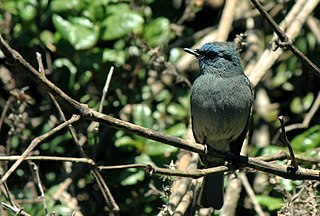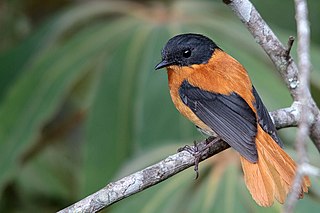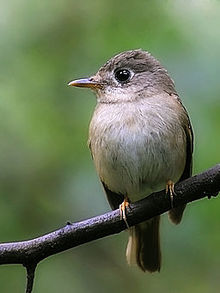
The spotted flycatcher is a small passerine bird in the Old World flycatcher family. It breeds in most of Europe and in the Palearctic to Siberia, and is migratory, wintering in Africa and south western Asia. It is declining in parts of its range.

The Asian brown flycatcher is a small passerine bird in the flycatcher family Muscicapidae. The word Muscicapa comes from the Latin musca, a fly and capere, to catch. The specific dauurica refers to Dauria, an area of south-eastern Siberia named after a local nomadic tribe.

The dull-blue flycatcher is a small passerine bird in the flycatcher family, Muscicapidae. It was previously included in the genus Muscicapa.

Tickell's blue flycatcher is a small passerine bird in the flycatcher family. This is an insectivorous species which breeds in tropical Asia, from the Indian Subcontinent eastwards to Bangladesh and western Myanmar. The Indochinese blue flycatcher was formerly considered conspecific. They are blue on the upperparts and the throat and breast are rufous. They are found in dense scrub to forest habitats. The name commemorates the wife of the British ornithologist Samuel Tickell who collected in India and Burma.

The Indian paradise flycatcher is a medium-sized passerine bird native to Asia, where it is widely distributed. As the global population is considered stable, it has been listed as Least Concern on the IUCN Red List since 2004. It is native to the Indian subcontinent, Central Asia and Myanmar.

The bar-winged flycatcher-shrike is a small passerine bird usually placed in the Vangidae. It is found in the forests of tropical southern Asia from the Himalayas and hills of southern India to Indonesia. Mainly insectivorous it is found hunting in the mid-canopy of forests, often joining mixed-species foraging flocks. They perch upright and have a distinctive pattern of black and white, males being more shiny black than the females. In some populations the colour of the back is brownish while others have a dark wash on the underside.

The sultan tit is an Asian forest bird with a yellow crest, dark bill, black upperparts plumage and yellow underparts. The sexes are similar. The female has greenish-black upperparts and a yellowish throat. The young bird is duller than the adult and has a shorter crest. It is the only member of the monotypic genus Melanochlora, which is fairly distinct from the Parus tits with the nearest relative being the monotypic Sylviparus.

The yellow-rumped flycatcher, also known as Korean flycatcher or tricolor flycatcher, is a species of flycatcher found in eastern Asia. A distinctive species with almost no look-alike other than the narcissus flycatcher. It breeds in eastern Asia including parts of Mongolia, Transbaikal, southern China, Korea and western Japan. They winter in parts of the Malay Peninsula and South Asia.

The black-and-orange flycatcher or black-and-rufous flycatcher is a species of flycatcher endemic to the central and southern Western Ghats, the Nilgiris and Palni hill ranges in southern India. It is unique among the Ficedula flycatchers in having rufous coloration on its back and prior to molecular studies was suggested to be related to the chats and thrushes.

The pale-capped pigeon, also known as the purple wood pigeon, is a species of large pigeon that is found patchily distributed in parts of the Indian subcontinent and Southeast Asia. It has a slow flight and spends a lot of time sitting still in the foliage of large fruiting trees, often in riverine forest on the plains. It is mainly brown above and chestnut below with the a sheen of green or amethyst. Males have a whitish grey cap while females have a brownish grey cap and less gloss on the feathers. They are frugivores, foraging in small groups in the canopy of trees but sometimes descending to the ground for seeds and fallen fruit.

The dark-sided flycatcher is a small passerine bird belonging to the genus Muscicapa in the Old World flycatcher family Muscicapidae. It has a wide breeding distribution in the East Palearctic with northern birds migrating south for the winter. It is also known as the Siberian flycatcher or sooty flycatcher, the latter name is also used for the sooty flycatcher of Africa.

The Palani laughingthrush is a species of laughingthrush endemic to the hills of the Western Ghats south of the Palghat Gap in Southern India. Found in the high montane forests, this grey bibbed, rufous bellied bird with a prominent dark eyestripe and broad white brow was grouped along with the grey-breasted subspecies of the black-chinned laughingthrush and known as the grey-breasted laughingthrush. This species is found in the Palni Hills while another closely related form, the Ashambu laughingthrush with a shorter white brow is found in the high hills south of the Achankovil Gap and was treated as a subspecies. The two forms were together treated under the name of Kerala laughingthrush.

The Mediterranean flycatcher is a small passerine bird in the Old World flycatcher family. It breeds on the Balearic Islands, Corsica and Sardinia, and is migratory, wintering in Africa. The International Ornithologists' Union has split the species from the spotted flycatcher, but other taxonomic authorities considered it still conspecific.















